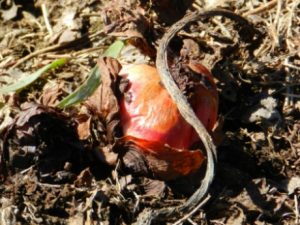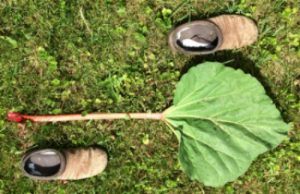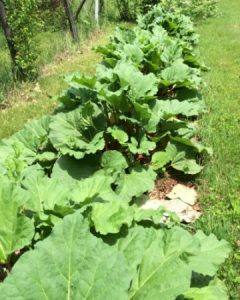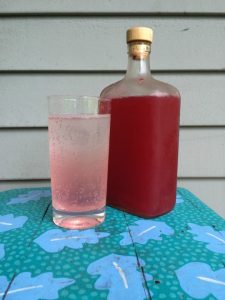
Rhubarb is one of the first plants to poke through the soil each spring. Its great knobs of wrinkled leaves pushing through mulch like a crowning baby’s head. In less than a month, the plants are gigantic. The leaves grow to the size and shape of the blade of a shovel, and the stalks ready for harvest.
We enjoy the tangy, astringent flavor of rhubarb before we even plant those hot-weather prima donnas: the tomatoes, eggplants and peppers.
Rhubarb is the taste of spring.

Only the stalks are edible. The leaves contain toxic levels of oxalic acid, but the pennant-sized leaves make good mulch. Kept mulched and weeded, rhubarb is easy to grow in rich soil, and it’s a perennial that comes back year after year.
Rhubarb was used medicinally in China as far back as 2,700 BCE, mostly as a digestive aid and laxative. It entered the European historical record in 1608, and was a highly prized medicinal by the middle of the seventeenth century. Back then, the Russians captured a monopoly, supplying it to Europe, where it was significantly more expensive than cinnamon, saffron or opium.
By the end of the eighteenth century, rhubarb was cultivated throughout Europe and England. Rhubarb came to North America around 1800, and is now grown across the northern United States and southern Canada. It requires cold temperatures to thrive.

My rhubarb came to me from a neighbor in 1985; his came from his mother, the town clerk who signed my marriage license; hers came from her mother, and so one, back through the generations.
I don’t know what variety my rhubarb is, just that it’s hardy and has flourished with minimal care. I transplanted some when I moved ten miles and twenty years ago, and I’ve given away crowns many times.
Whatever the variety, it’s delicious, and I’ve been collecting and fine-tuning recipes with my abundant crop, including rhubarb coffee cake, upside down cake, crisp, and pie; rhubarb marmalade, jam (plain and with strawberries), chutney and sauce. We also eat rhubarb sweetened and stewed and savory and spiced. My current favorite is Simple Rhubarb Syrup, which makes a tangy substitute for lemon or lime in water, seltzer, lemonade, or mojito.
To make Simple Rhubarb Syrup: Place about two pounds (8 cups) of chopped rhubarb in a large saucepan, add water to cover, bring to a boil and simmer for 20-30 minutes, skimming off any scum that rises to the surface.

When the rhubarb has disintegrated, strain through a fine mesh strainer. (If you want to be fancy, line the strainer with coffee filters or cheesecloth.)
This juice is delicious as is, and will keep a week or so in the fridge; longer in the freezer. (Make ice cubes with it!)
But rhubarb is notoriously tart, and most people add sugar, which enhances the flavor. I add a scant-half cup of cane sugar and reduce the liquid by simmering for another twenty minutes.
Cool, decant and refrigerate.
Makes about four cups.
If you have a fabulous rhubarb recipe you’re willing to share, I’d love to give it a try.
Living in Place chronicles my rooted and rural existence. While I’m traveling this summer, I’m rerunning some of my personal favorites, in case you missed them the first time around, or meant to try making rhubarb syrup but forgot where you read the recipe.
Thanks for reading. Look for replies to your comments in mid-July.
Nice history! Never realized rhubarb wasn’t new world. Thanks for the recipe! Gets me thinking of using the syrup in a spicy salsa in place of lemon or lime.
Yes, I thought rhubarb was not just New World but specifically New England. Not at all! It’s ancient and global, with a deep medicinal and political history. And rhubarb salsa? Delish! I’m always a willing taster as you perfect your recipe . . .
A new favorite post for me. Freeze plenty for my return?
Xoxoox
Will do! xxx